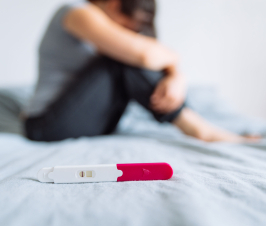Did you know that cervical cancer was once the leading cause of death for women in the United States? Thankfully, thanks to routine Pap smear screening, the number of case of cervical cancer and cancer related deaths has declined significantly over the past 40 years. However, it is estimated that approximately 12,000 new case of cervical cancer are diagnosed in the United States each year. This number does not include cervical pre-cancers, also known as cervical dysplasia. Cervical pre-cancers are diagnosed far more often than invasive cervical cancer because they are routinely confirmed when regular interval Pap screening is performed.
We now know that the main risk factor for the development of cervical dysplasia and cervical cancer is the presence of the human papilloma virus (HPV) infection. HPV is contracted through sexual contact and is the most common sexually transmitted infection. It is estimated that nearly all sexually active men and women contract the virus at some point in their lives. Women under the age of 30 frequently clear the virus on their own, through the support of a healthy functioning immune system and thus, are not routinely screened for the virus. Routine screening for HPV is conducted along with the pap in women over the age of 30, who may clear the virus more slowly or not at all without intervention, resulting in persistent HPV infection and increased risk for the development of cervical cancer.
The diagnosis of HPV, cervical dysplasia, or some combination of the two often elicits fear, anxiety, or stress in a woman faced with this challenge. Furthermore, a “watch and wait approach” is often recommended when certain combinations of HPV and pap findings are confirmed; this can be distressing for women who wish to actively treat their condition. Fortunately, naturopathic medicine offers a variety of oral and vaginal protocols that can be initiated to support the body in clearing HPV and reversing abnormal pap findings consistent with cervical dysplasia. This article will focus on safe and effective natural interventions that can be administered orally as part of an HPV oral protocol. In my practice, I recommend the following supplements to be taken daily over a period of 6 months.
Diindolylmethane (DIM)
DIM is a byproduct of indole-3-carbinol (I3C), a substance found in cruciferous vegetables such as broccoli, brussel sprouts, cabbage, kale, and cauliflower. When I3C contacts the acidic environment of the stomach, DIM is formed. The use of cruciferous vegetable indoles has importance in the prevention and control of cervical dysplasia.
DIM has been shown to exhibit a wide range of anti-tumor and biological effects against tumor cells. Collectively, DIM has been shown to promote cancer cell cycle arrest and suppress angiogenesis (formation of new blood vessels in tumors). DIM directly disrupts various stages of HPV proliferation in both the onset and progression from cervical dysplasia to cervical cancer through inhibition of key viral transcripts.1
DIM also elicits positive hormonal effects through alteration of the metabolism of estrogen. Studies have shown that cervical cancer cells transformed by HPV 16, 18 (two of the known high-risk HPV subtypes) alter estrogen metabolism towards a more unfavorable pathway known as C-16 hydroxylation. C-16 hydroxylation produces a carcinogenic (cancer causing) byproduct that promotes the progression of HPV.2 DIM alters the directional pathway of estrogen away from C-16 hydroxylation thereby eliciting anti-viral and anti-proliferative effects. DIM has also been shown to support immune function through the up-regulation of several key cytokines (chemical messengers) that target the overall immune response to HPV.3
A small 2010 pilot study evaluated the efficacy and toxicity of oral DIM in the treatment of cervical dysplasia. 64 participants with biopsy proven cervical intraepithelial neoplasia (CIN) 2 or 3 were randomized to receive 2 mg/kg/day of oral DIM or placebo for 12 weeks. Subjects were evaluated every 3 – 4 months for 1 year with Pap smear, HPV, colposcopy, and cervical biopsies.4 No systemic toxicities were observed and only two participants (3%) reported nausea with use. 47% of subjects in the DIM group had improved CIN with a decrease of 1 – 2 grades or a normal result; median time to improvement was 5 months. 49% of participants in the DIM group showed improved or normal pap smear results and 56% showed improvements in colposcopy results. While promising, no statistically significant difference in any outcome was seen between the DIM and placebo group.
DIM can be taken orally as a dietary supplement in the treatment of HPV. Typically, supplementation is recommended daily for a minimum of six months, at which time pap and HPV testing may be repeated. As mentioned in the study above, median time to improvement was noted at 5 months. Alternatively, dietary consumption of 1 – 2 cups of cruciferous vegetables daily will provide the appropriate level of DIM required in the treatment of cervical dysplasia and HPV.
Coriolus versicolor
Coriolus versicolor, also known as Turkey Tail, is a medicinal mushroom historically used in Asian countries for its immune boosting and anti-cancer properties. Coriolus contains polysaccharides, specifically beta-glucans, that have been shown to exhibit immunomodulatory and anti-tumor effects.
Of these polysaccharides, polysaccharide-K (PSK) and polysaccharide-peptide (PSP) are the most frequently researched. PSK and PSP have been shown to elicit anti-cancer effect through induction of apoptosis (cell death), inhibition of DNA replication, cell cycle arrest, and through suppression of cancer cell adhesion, migration, and invasion.5 Coriolus may also support the immune system’s ability to target and eradicate cancer through increased production of lymphocytes, T cells, and natural killer cells.6
The activity of coriolus versicolor has been established to elicit positive effect against HPV and cervical dysplasia in recent studies. A 2008 clinical trial evaluated 39 patients with low-grade squamous intraepithelial lesions (LSIL), 22 of which exhibited positive high risk HPV status. Two groups were formed including a control group with no treatment and a group administered 3 grams coriolus per day over one year. Coriolus supplementation yielded a 72% regression rate in LSIL compared to 47.5% in those without supplementation. Furthermore, supplementation with coriolus demonstrated a 90% regression rate in the high-risk HPV subtypes compared to 8.5% whom did not receive supplementation.7
Of interest, research performed at the Bulgarian University Hospital of Obstetrics and Gynecology has also shown similar clearance rates of HPV in participants receiving coriolus alone or coriolus plus surgical intervention. Of 100 HPV positive (both low and high-risk subtypes) women, 64 (88%) of 73 patients receiving coriolus alone were HPV negative at the end of the 6 month study period compared to 25 (93%) whom received combined therapy. 11 patients remained HPV positive, all of whom exhibited high risk HPV subtypes. In this study, the HPV 16 subtype was found to be the most resistant to treatment.8
Coriolus is generally administered as a daily oral supplement. It is generally well tolerated, even at higher doses of 9 grams daily, with no systemic toxicities reported. However, may over-the counter Coriolus products are not standardized and use different extraction processes, making it difficult to compare potencies between brands. The hot water extraction is generally considered to be the most effective method to release, concentrate, and preserve the bioactive polysaccharides required for therapeutic benefit.
Green tea extract
Epigallocatechin-3-gallate (EGCG) is a powerful phytochemical found in green tea with many therapeutic benefits. It is commonly touted as the most abundant and powerful antioxidant in green tea for cancer prevention. EGCG has been shown to inhibit growth factors responsible for the proliferation of cervical dysplasia. Other studies suggest EGCG can induce apoptosis of cancer cells, inhibit cervical cancer cell lines in vitro, and influence alterations in gene expression. In vivo antitumor effects of EGCG have also been observed.9
A study of 51 women with cervical lesions ranging from chronic cervicitis, mild, moderate, or severe dysplasia were divided into four groups as compared to 39 controls. Group 1 (27 patients) received twice-weekly local application of a vaginal green tea polyphenol with 74% of participants showing a response. Group 2 (6 patients) received an oral 200 mcg EGCG capsule daily with a 50% response rate. Group 3 (8 patients), received combination therapy with both the oral EGCG and vaginal green tea application with a 75% response rate. Group 4 (10 patients) received a higher dose of EGCG (dose unknown) with a 40% response rate. Overall, a 69% response rate was seen in those receiving a green tea product as compared to a 10% response rate in the untreated control,10suggesting the delivery of green tea extracts in either an oral or vaginal delivery as a safe and effective adjunct in the treatment of cervical lesions.
Green tea extract may be administered as an oral supplement or through dietary consumption. If dietary consumption is preferred, drinking a minimum of 3 cups of green tea daily is recommended for optimal therapeutic benefit.
Folic acid
The use of folic acid as part of an oral HPV protocol arises largely from data suggesting that higher folic acid levels are associated with a significantly lower risk of cervical dysplasia.11 Thus, folic acid deficiencies may represent a risk factor for the development of cervical pre-cancers. Earlier studies have also concluded that low folate levels enhance the effect of other risk factors for cervical dysplasia and in particular, that of the HPV 16 subtype.12 Newer research has also begun to elucidate the effect of folic acid levels in individuals affected by the MTHFR polymorphism, a genetic mutation that can result in inefficient or reduced folate metabolism. A recent meta-analysis observed that individuals with the MTHFR C677T mutation and lower folate status are predisposed to a higher risk of CIN2+. In contrast, higher folate levels my compensate for the reduced activity of the MTHFR C677T polymorphism and in turn mount a protective immune response against high risk HPV subtypes.13 Oral folic acid supplementation represents an important component in both the prevention and treatment of cervical dysplasia and is a simple, safe, and effective addition to the HPV oral protocol.
Because of the high folic acid doses required to elicit therapeutic effect in the treatment of HPV and cervical dysplasia, oral supplementation with folic acid capsules is most often recommended.
Other considerations
Beta-carotene, vitamin C, vitamin E, and CoQ10 are also common prescriptions in the treatment of HPV and cervical dysplasia. Studies have shown lower levels of each of these nutrients in women with CIN as compared to controls. Vitamin C is an important consideration in smokers, as tobacco use is causally related to the development of cervical cancer and naturally depletes vitamin C levels. Nicotine has been shown to elicit a direct carcinogenic and local immunosuppressive effect on the cervix14 and most female smokers are not aware that nicotine from cigarette smoke can be found in cervical cells. Thus, the addition of vitamin C to the HPV oral protocol is an important inclusion in patients who smoke.
Natural local treatments for cervical dysplasia may include ablative therapy known as the escharotic treatment or the use of specialty compounded vaginal suppositories containing natural medicines known for their anti-HPV effect and ability to reverse abnormal cervical changes. A licensed naturopathic physician is able to prescribe and administer both of these therapies, however, these treatments may not be indicated in all women and require a careful and detailed evaluation of the medical history to determine eligibility. Conventionally, surgical interventions known as the loop electrosurgical excision procedure (LEEP) or cone biopsy may be recommended to treat cervical dysplasia and must be carried out by an appropriately trained gynecologist. For an excellent description of the escharotic treatment, see the article by my NaturalPath colleague Jenny Abercrombie, ND.
Summary
When a woman is diagnosed with cervical dysplasia or HPV, she deserves a thorough, thoughtful, and informed conversation regarding options for her cervical health, including both natural and conventional treatment options. Naturopathic medicine shines in its ability to support the immune system, reverse abnormal cervical changes, and target HPV naturally, effectively, and with minimal side effects. Because severity and location of disease may preclude some women from pursuing local applications of natural medicine in the treatment of cervical dysplasia, I recommend all women establish a comprehensive care team with both a gynecologist and a naturopathic physician to develop the most comprehensive treatment available. Consultation with a naturopathic physician is important so that the appropriate dosing and types of supplementation can be prescribed to tailor the treatment regimen individually.
 Dr. Michelle Cameron is a licensed naturopathic physician and graduate of the National College of Natural Medicine (NCNM) in Portland, OR, where she received a Doctorate of Naturopathic Medicine in 2013. Following graduation, Dr. Cameron completed a two year-residency program with a primary focus in women’s health and gynecology under the mentorship of Dr. Tori Hudson. She currently maintains a private practice at A Woman’s Time, an integrative natural medicine clinic located in downtown NW Portland.
Dr. Michelle Cameron is a licensed naturopathic physician and graduate of the National College of Natural Medicine (NCNM) in Portland, OR, where she received a Doctorate of Naturopathic Medicine in 2013. Following graduation, Dr. Cameron completed a two year-residency program with a primary focus in women’s health and gynecology under the mentorship of Dr. Tori Hudson. She currently maintains a private practice at A Woman’s Time, an integrative natural medicine clinic located in downtown NW Portland. Dr. Cameron has a strong understanding and passion for bio-identical hormone prescription and enjoys treating women of all ages and stages of life for their unique health care needs. Strong areas of focus for Dr. Cameron also include polycystic ovarian syndrome (PCOS), endometriosis, chronic vaginitis, weight loss, and cervical dysplasia. She is also trained as a holistic pelvic floor provider and provides pelvic floor therapy for the treatment of a variety of pelvic issues. Dr. Cameron is currently the only physician in Portland whom offers the O-shot®, a non-invasive procedure that utilizes the healing potential of platelet rich plasma in the treatment of female sexual dysfunction and urinary stress incontinence. In her down time, she loves cooking, gardening, exercising, and sleeping.
References:
- Carter, TH, Liu K, Ralph W Jr., et al. Dindolylmethane alters gene expression in human keratinocytes in vitro. J Nutr. 2002; 132: 3314 – 24.
- Sepkovic, DW, Stein J, Calrise, A, et al. Results from a dose-response study using 3, 3’-Dindolylmethane in the K14-HPV 16 transgenic mouse model: cervical histology. Cancer Prev Res. 2011; 4: 890.
- Xue, L, Pestka J, Maoxiang, L, et al. 3, 3’-Dindolylmethane stimulates murine immune function in vitro and in vivo. J Nutr Biochem. 2008; 19: 336-44.
- Wan, JMF, Sit WH, Yang X, Jiang P, Wong LY. Polysaccharopeptides derived from Coriolus versicolor potentiate the S-phase specific cytotoxicity of Camptothecin (CPT) on human leukemia HL-60 cells. Chinese Medicine. 2010; 5: 16.
- Jiang, J and Sliva D. Novel medicinal mushroom blend suppresses growth and invasiveness of human breast cancer cells. Int J Oncol. 2010; 37(6) 1529 – 36.
- Torkelson, CJ, Sweet, E, Martzen, M, et al. Phase I clinical trial of Trametes versicolor in women with breast cancer. ISRN Oncol. 2012: 251632.
- Couto, S. Evaluation of coriolus versicolor supplementation in HPV patients. Clinical Journal of Mycology. 2007. Vol 2, Ed 1:2 – 5.
- Borisov, S. Coriolus-MRL : Assessment of the effect on patients infected with low and high-risk types of HPV. Clinical Journal of Mycology. 2012; 3(2)2-3.
- Ahn, WS, Huh, SW, Bae, SM, et al. A major constituent of green tea, EGCG, inhibits the growth of a human cervical cancer cell line, CaSki cells, through apoptosis, G(1) arrest, and regulation of gene expression. DNA Cell Biol. 2003; 22(3): 217 – 24.
- Ahn, WS, Yoo J, Huh S, et al. Protective effects of green tea extracts (polyphenon E and EGCG) on human cervical lesions. Eur J Cancer Preve. 2003; 12(5)389-390.
- Piyathilake, CJ, Macaluso, M, Alvarez, RD, Bell, WC, Heimburger, DC, Partridge EE. Lower risk of cervical intraepithelial neoplasia in women with high plasma folate and sufficient vitamin B12 in the post-folic acid fortification era. Cancer Prev Res. 2009; 2(7): 658-64.
- Butterworth, CE Jr., Hatch, KD, Maculauso, M et al. Folate deficiency and cervical dysplasia. JAMA. 1992; 267(4): 528 – 33.
- Badiga, S, Johanning GL, Macaluso M, et al. A lower degree of PBMC L1 methylation in women with lower folate status may explain the MTHFR C677T polymorphism associated higher risk of CIN in the US post folic acid fortification era. PLoS One. 2014; 9(10): e110093.
- Fonsesca, Moutinho, JA. Smoking and Cervical Cancer. ISRN Obstet Gynecol. 2011: 8476884.
















